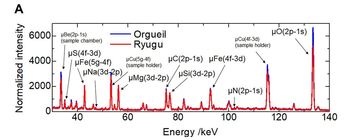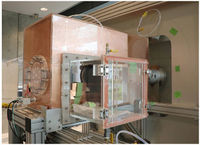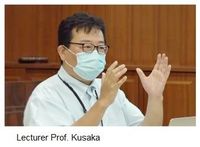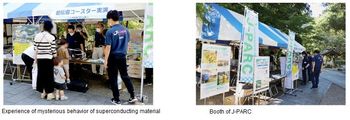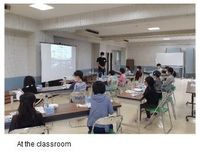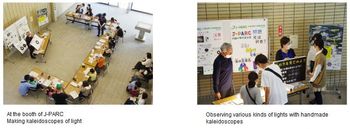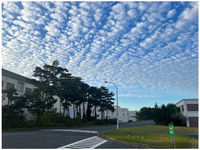J-PARC News November 2022 (Issue #210)
■Successful Nondestructive Elemental Analysis of Stones from Asteroid Ryugu by Elementary Particle Muons
-Possibility to Be New Standard Sample Representative of Solar System-(September 23)
A team from the Japan Aerospace Exploration Agency, Tohoku University, KEK, J-PARC Center, Japan Synchrotron Radiation Research Institute, Hokkaido University, Kyoto University, Kyushu University, Hiroshima University, and the University of Tokyo has analyzed the Ryugu rocks brought back by the asteroid probe Hayabusa2 and found water in liquid form containing carbon dioxide, organic matter, and salt, and has attested to the theory that the asteroid impacted the earth and originated oceans and lives.
This is the world-first accomplishment. The team published a press release titled "Asteroid Explorer Hayabusa2 Initial Analysis Stone Team Reveals Formation and Evolution of Carbonaceous Asteroid Ryugu" and announced that a paper has been published in the US scientific journal "Science".
The third-largest sample from Ryugu was assigned to the team and irradiated with the world's highest-performance negative muon beam generated at the pulsed muon facility, J-PARC MUSE (abbreviation of MUon Science Establishment) for about a week last June and July. The team obtained muon characteristic X-ray spectra without destroying the sample at all. The result shows that the composition of Ryugu is generally similar to that of CI chondrites which are considered to be the most primitive material that retains remnants of material from the early solar system, and are also used as a criterion for the chemical composition of individual materials in the solar system. This indicates that the Ryugu rocks are extremely primitive materials in the solar system. Furthermore, it is found that the Ryugu sample contains only 25% less oxygen than the CI chondrites. This suggests that terrestrial materials contaminated CI chondrites and that Ryugu stones may be more suitable as representative solar system materials.
For more information, please visit the J-PARC website.
https://j-parc.jp/c/press-release/2022/09/23001011.html
Asteroid Explorer "Hayabusa2" Initial Analysis of the Material Analysis Team's Research Results Paper Published in the Scientific Journal "Science".
https://j-parc.jp/c/press-release/2022/09/23001010.html
★You can watch how the analysis at J-PARC was conducted below.
J-PARC News Special Issue: "Samples from Asteroid Ryugu, Analysis Begins at J-PARC"
https://j-parc.jp/c/topics/2021/07/15000718.html
★We have displayed the actual muon analysis chamber in the MLF lobby at J-PARC.
■J-PARC Workshop "Progress for Fundamental Physics with Neutrons" held (September 28-29)
J-PARC Center, Institute of Materials Structure Science of High Energy Accelerator Research Organization (KEK), and Institute of Particle and Nuclear Studies of KEK jointly hosted "Progress for Fundamental Physics with Neutrons" at KEK Tokai Building No.1 and J-PARC Research Building. Neutrons are particles without electric charge, sensitive to gravity, and their wave nature significantly appears at low energies. With these unique properties, we are conducting various cutting-edge experiments to study fundamental physics, from quantum mechanics and gravity to the formation of the universe. This workshop was hosted as an information-sharing forum for researchers who are promoting fundamental physics with neutrons.
The workshop was held in a hybrid format with 15 onsite and 45 remote participants. A total of 16 presentations from Japan and abroad joined, and participants discussed future research directions. Further, they also discussed the applications of the new instruments and measurement techniques developed for materials. It is expected that this will be an opportunity to stimulate basic physics research using neutrons.
■J-PARC Hello Science "What can we do with the Ibaraki Prefectural device iBIX?" (September 30)
The lecturer of the September “Hello Science" was Professor Katsuhiro Kusaka of the Prefectural BL Development and Research Division of Frontier Research Center for Applied Atomic Sciences, Ibaraki University. He introduced one of the Ibaraki Prefecture's two unique neutron beamlines installed at the MLF, the iBIX (IBARAKI Biological Crystal Diffractometer). By this instrument, the three-dimensional structure of proteins, which work in a variety of ways in the bodies of living organisms by neutrons, can be seen. It means that the use of neutrons allows us to observe light elements more, especially hydrogen atoms that are important for protein function, and difficult to see with X-rays.
Proteins are one of the important components of the human body, along with water and fat, and are high-molecular compounds consisting of chains of 20 different amino acids. iBIX uses neutron diffraction, which uses the interference phenomenon of scattered waves (neutrons) to determine the relative position and size of the scatterers (atoms), to study the three-dimensional structure of proteins that exhibit a wide variety of shapes. Prof. Kusaka introduced the structure and mechanism of the iBIX detector and other beamline instruments and stated the reaction mechanism of cellulolytic enzymes, the elucidation of the fibrosis of the protein responsible for the amyloid disease, and the result of observation of specific hydrogen in the enzyme responsible for vascular damage in diabetes mellitus. It is expected to see applications in medicines without side effects, enzyme detergents, and foods, that are useful in our daily lives.
■Workshop at Ozora Marche 2022 (October 1, Tokai village)
The "Ozora Marche" autumn event in Tokai village was held for the first time in four years, and the J-PARC Center exhibited craft lessons for bead straps that change color under ultraviolet light and a superconducting coaster at the kids' corner. More than 500 parents and children visited our booth and enjoyed the mysterious behavior of superconducting materials. The location of this event was in the precincts and approaches to the "Grand Shrine," which enshrines a branch spirit of the Ise Jingu Shrine, and the “Muramatsuyama Kokuzoudo”, one of the Japanese three prominent Kokuzosons. This event aimed to convey the appeal of the culture and history of the Tokai village to the next generation. Blessed with fine weather, the event attracted many visitors with numerous booths including handmade crafts, workshops, a food court, and a live stage in an atmosphere of deep history and holiness.
■Lecture at KIPP Nakameguro, Children's After-school Care Program at Nakameguro Elementary School (October 8)
On October 8, the J-PARC Center held a lecture titled "World's Smallest? Let's get to know the elementary particles by making a mysterious spinning top!" The participants were 14 students from the first to sixth grades of elementary school. They rotated the gyroscope and experimented to see what happened when they changed the center of gravity of the handmade top. The lecturer was Dr.Tsutomu Mibe of the Particle and Nuclear Physics Division. Even first-year students focused on the lecture for the full 90 minutes. Moreover, many of them wrote in the questionnaire that they had enjoyed the lecture.
■Workshop at Open-house of QST in Naka (October 16)
The J-PARC Center conducted a workshop, "Let's Make a kaleidoscope of Light", at the open-house event of the Naka Fusion Institute of the National Institutes for Quantum Science and Technology. This workshop has been performed at other events and well received.
In a typical kaleidoscope, the image of beads and pieces of plastic is reflected by a mirror inside the tube, making the kaleidoscope look multilayered. However, "Kaleidoscopes of Light" do not use mirrors or beads at all. Instead, by attaching a spectroscopic sheet to the peeping window, light from holes drilled with pins at the bottom of the tube appears to spread in all directions, shining in rainbow colors.
In the mild autumn sunshine, many people visited this event, and 171 parents and children gathered at the J-PARC booth to learn about spectroscopy’s principles and enjoy making "Kaleidoscopes of Light" crafts.
■Mr. Yuga Nakazawa Wins Student Poster Prize at LINAC2022, the International Linear Accelerator Conference
The research group investigating the properties of muons, one of the elementary particles, is preparing the experiment to precisely measure the anomalous magnetic moment (g-2) and the electric dipole moment (EDM) using the high-quality muon beam. One of the core technologies of this experiment is an unprecedented linear accelerator dedicated to muons. Mr. Yuga Nakazawa, a graduate student at Ibaraki University, recently gave a poster presentation at the International Linear Accelerator Society LINAC2022 on his empirical research of an interdigital H-mode drift tube linear accelerator dedicated to muons (IH-DTL) and received the Second Student Poster Prize [*].
The IH-DTL is a sort of drift tube linear accelerator (DTL), and we use the Alvarez-type DTL in the first stage of the J-PARC accelerator because of its superior performance, especially in accelerating low-velocity particles. The IH-DTL has higher efficiency than the Alvarez-type DTL. Further, by incorporating the alternative phase focusing (APF) technique, in which a high-frequency electromagnetic field for particle acceleration is also used for beam focusing, even higher performance can be achieved for low-current beams, and has been used in a linear accelerator for heavy ion therapy. However, the acceleration of muons, which have a mass of less than one-tenth of that of proven heavy ions, has a heavy influence due to error electromagnetic fields. Therefore, it was unknown whether the high-quality acceleration required for g-2/EDM precision measurements could be achieved. Then, Mr. Nakazawa built a prototype IH-DTL dedicated to muons and conducted electromagnetic field measurements and tests of applying the RF power necessary to accelerate muons. In this way, he demonstrated the IH-DTL acceleration cavity technology necessary to realize high-quality acceleration of muons. This result will be published in Physics Review Accelerator and Beams in addition to the Best Student Presentation Award at LINAC2022.
Based on this technology, we have already fabricated an actual IH-DTL dedicated to muons and are undergoing experiments to adjust [**]. The muon-dedicated linear accelerator consists of four types of accelerators including the IH-DTL, and the actual accelerator cavities after the IH-DTL are also under construction. The experimental group is now preparing for experiments including the muon-dedicated accelerator to start experiments in 2027.
[*] International Linear Accelerator Conference LINAC2022HP
[**] From J-PARC Photo Gallery
https://j-parc.jp/c/photo_gallery/2022/03/ih-dtl-1.html
https://j-parc.jp/c/photo_gallery/2022/03/ih-dtl.html
★Please click here to see the J-PARC Photo Gallery.
https://j-parc.jp/c/photo_gallery/index.html
■Sanpo-michi㉘ -Bright Autumn Sky Underneath
Scaly clouds have appeared all over the sky above J-PARC. At first glance, they appeared to be neatly arranged, but closer inspection revealed that no two are alike.
Scaly clouds covered more than half the area of the sky. And yet this sky looked brighter and clearer than a clear cloudless sky. It also gave the entire sky much more depth.
Shadows were cast by the huge MLF building. The shadow was long and thin, and its outline was blurred. If you follow the shadow, it would stretch ahead and ahead as the sun went down.
After passing the fifteenth night, the ears of silver grass continue to grow to send the seeds they have put forth farther and wider.
It is a scene of an autumn evening when everything stretches itself.


